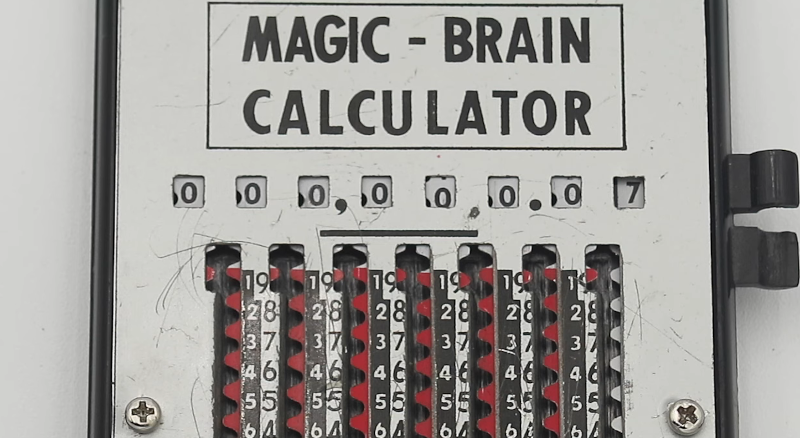If you predate the pocket calculator, you may remember slide rules. But slide rules take a a little skill to use. There was a market for other devices that were simpler or, in some cases, cheaper. One common one was the “magic brain” or Addiator which was a little metal box with some slots that could add numbers. However, using clever tricks it could also subtract and — in a fashion — multiply. [Our Own Devices] has a teardown of the device you can see in the video below. It is deceptively simple, and the description of how it works is at least as interesting as the peek inside.
We remember these on the market and, honestly, always thought they were simple tally mechanisms. It turns out they are both less and more than that. Internally, the device is a few serrated sheet metal strips in a plastic channel. The subtraction uses a complement addition similar to how you do binary subtraction using 2’s complement math. Multiplication is just repetitive addition, which is fine for simple problems.
Normally, these devices are hard to open because they are riveted. However, [Jim] drilled his out and replaced the rivets with screws. It looks odd but much nicer for opening it up.
If the video doesn’t make sense, you can always consult the original instructions. We were surprised we couldn’t find a JavaScript simulator somewhere, although this online calculator might help a little. According to the Slide Rule Museum, the original version of this was the “Baby Calculator” made by a company around Chicago, possibly as early as 1917. The magic brains were Japanese imports and there were many other variants that you can find in the museum’s document.
We couldn’t help but think of the Smarty Cat slide rule we have in our collection. Most of our slide rules are, however, more conventional.

















Wow! Fascinating. I love the simple beauty of the mechanical era.
Plus the ability to tease by losing the slide on a slide rule.
The Addiator was a popular addition to the backs of slide rules. The addiator was used for addition/subtraction and the slide rule for multiplication/division.
I used to use one of these to do my income tax. It wasn’t labeled as a magic brain though.
You used one of these to do your taxes? Was that before or after the Boston Tea Party? Just kidding.
*puts pen in coat pocket without breaking eye contact*
This guy is ok in my book.
I was handed down one of these when I was 6 and a Marine brat in Japan. I was familiar with the concept of adding machines, abacus still being ubiquitous at the front counter of mom & pop stores, and my grandfather owning an electro-mechanical device stateside. But, I wasn’t able to make heads or tails of the algorithm to make the Magic Brain work. It wouldn’t have helped to ask mom or dad, because I was expecting a device that (if I’d had the words) implemented the algorithm in hardware. This being the mid-60s, a Curta would have done nicely. My techno fulfillment didn’t come until 7 years later when I got my first electronic calculator for Christmas.
When I was in elementary school in the Netherlands one of my friends had one and we really thought it was magic. Must have been 1972 – 1975
Had one or two around 70 years ago. Sleeker than the one shown though.
Actually addition isn’t always the easier operation to implement in electronics. The Univac 1100 series (at least the earlier ones) implemented an electronic subtractor and used subtraction of the one’s complement to perform addition.
Addiator’s big brother
https://www.ebay.com/itm/155832752676?hash=item24485b1a24:g:XvoAAOSw0kFlLYbH&amdata=enc%3AAQAIAAAA0BblFaGOGFN%2Fshj9rqRIC4eZ9j7z9dR5eQAjuKRW22bjztlMEAN2j%2FTVtictSNcKLCAJ2xUqKxw%2FeCT%2FlM2k9JbwN%2BCyMkbTczO7a20LA0J0G5tPpGuJ5xfDZxdrT%2FbbXbozZr6juH57lgEbCFMycfYNnfEj6GHyCxvMuZuWp5EO2ybAJOQ0zB8Dmv%2FTLz1sN32YdPTIZZL%2Frhg0sa002lbAsxB83n3XBx4oWO2hL%2BDOt2aWo4CmaU4zA%2FjxTvG7JSjmoxb28nVzOip3MUxaYDA%3D%7Ctkp%3ABk9SR-LdksrqYg
I was happy to add one to my collection a few years ago.
About 10 years ago, I saw one of these at my next door neighbor’s garage sale…
https://www.ebay.com/itm/145364796999?_trkparms=amclksrc%3DITM%26aid%3D1110018%26algo%3DHOMESPLICE.COMPLISTINGS%26ao%3D1%26asc%3D256454%26meid%3D2c40e48565d1464c90400821fd18f581%26pid%3D101196%26rk%3D7%26rkt%3D12%26sd%3D155832752676%26itm%3D145364796999%26pmt%3D1%26noa%3D0%26pg%3D4429486%26algv%3DCompVIDesktopATF2V3WithQueryItemRecallV3&_trksid=p4429486.c101196.m2219&amdata=cksum%3A1453647969992c40e48565d1464c90400821fd18f581%7Cenc%3AAQAIAAABALHyIAEaemKG0mx4REjf%252BHxECBsXtSkNHsCLmXz%252FJyCDeX%252FaDb78456J9CQJiWkf1mlyLkBBbJjT8Vr3JLZTlPt%252BIKaQh68UFDeyXqB4O1Z2757YQ1Vq9MPTY1CR456rEwIOC00lhjuEXtmdOmK5YHiM1oSkOyO%252Byy%252FPLzJ%252FnHdtR7%252BpBtsyPtVbRPG2gfzKoGe%252FitLs0Wq%252F1tzOzwAMAsEUhA6efroV%252B4AVPs%252FHZq7m7rVd6OwlKzEvLwqO1wjwKof%252FJ3wnyzPrMI0VT1hbH30GE8t0oGtc4uTiwty48yIFCI6WnjZKzHjtbvxj0kd43ovej0tBGO5CdHwYXP3688Y%253D%7Campid%3APL_CLK%7Cclp%3A4429486
I almost bought it, but then her husband saw me with it, and took it back!
I was given a pencil case in the 4th grade which had a slide cursor window that lined up x with that dreaded multiplication table which we had to memorize and I couldn’t and the nun scolded me for using it.
So this one multiplied (ROM) only 2 to 9 or higher I don’t remember.
we waiting for 3d printing version
Try the circular slide rule. You can’t fall of the end! I still have mine.
Why wait?
https://www.thingiverse.com/thing:2425746
I think the laser cut one looks easier to read.
https://www.thingiverse.com/thing:3612349
Although by switching filament colors to make the digits stand out or at least just painting them I bet the printed one would be good too.
mmm That was supposed to be a reply to @rthretrt
Is this really easier than just doing the math in one’s head though?